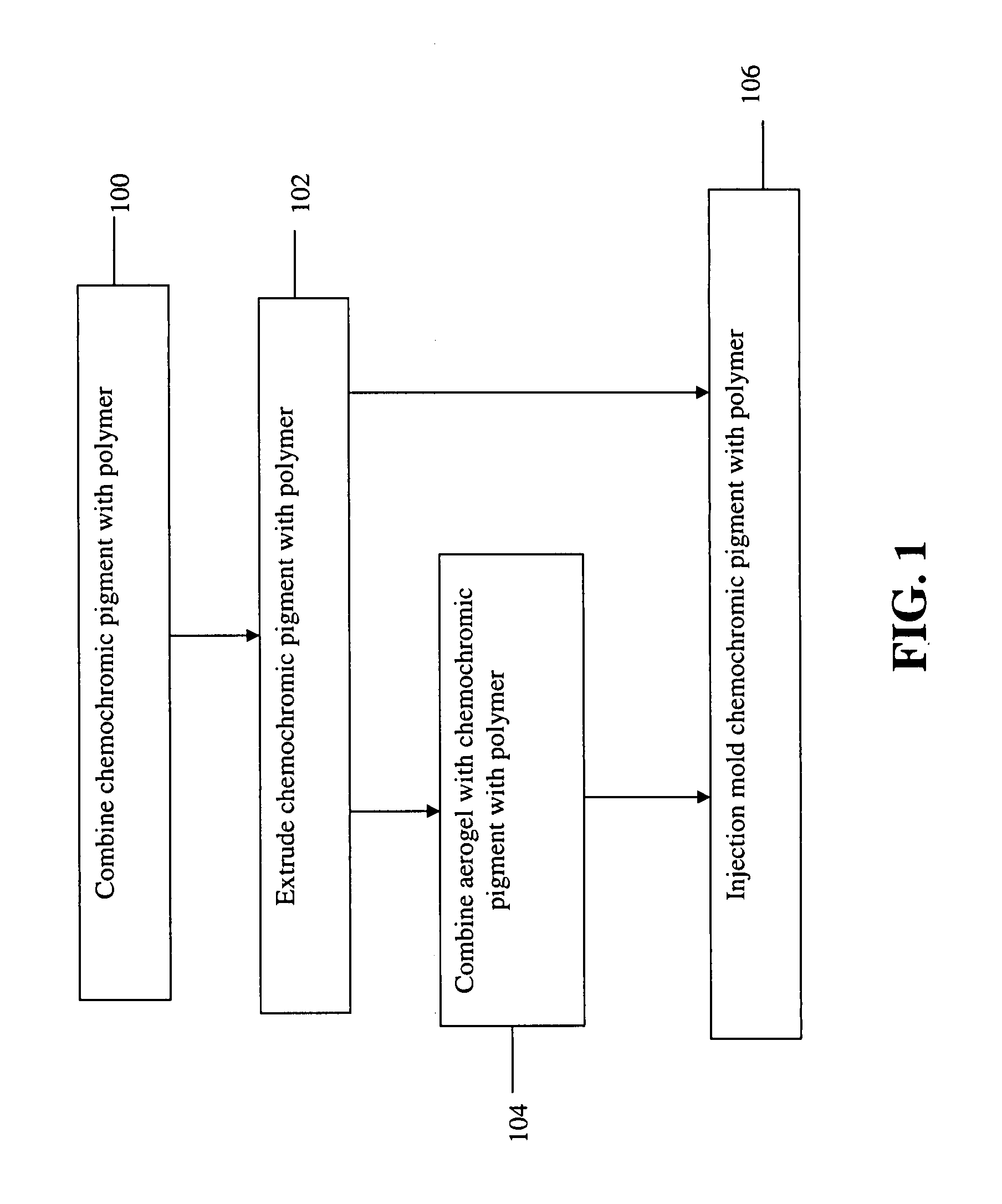Chemochromic Detector for Sensing Gas Leakage and Process for Producing the Same
a chemochromic detector and gas leakage technology, applied in the direction of chemical indicators, dye addition to spinning solution, instruments, etc., can solve the problems of easy leakage, difficult monitoring of hydrogen leakage, destruction of property, loss of life, etc., and achieves no power consumption, low cost, and simple application and removal
- Summary
- Abstract
- Description
- Claims
- Application Information
AI Technical Summary
Benefits of technology
Problems solved by technology
Method used
Image
Examples
example 1
Preparation of the Hydrogen Detector without Aerogel
[0042]1.5 weight percent hydrogen sensing pigment was dry mixed with 98.5 weight percent base polymer material, i.e. Dow VERSIFY 2300. The dry mixture was extruded using a counter-rotating Brabender twin screw extruder at zone temperatures of 185, 190, 195 and a die temperature of 200° C. The die was either a 2-inch or 6-inch ribbon die for tape extrusion. Screw speeds of 35 and 60 rpms were used for the 2-inch and 6-inch dies respectively. Draw of the ribbon reduced the width of the tapes to 1.5 and 4.5 inches. Tape thicknesses were kept between 0.5 and 0.7 mm.
example 2
Preparation of the Hydrogen Detector with Aerogel
[0043]3.0 g hydrogen sensing pigment was dry mixed with 10.0 g Aspen Aerogel and 187 g of base polymer material, i.e. Dow VERSIFY. The dry mixture was extruded using a counter-rotating Brabender twin screw extruder at zone temperatures of 190, 195, 195 and a die temperature of 200° C. The die was either a 2-inch or 6-inch ribbon die for tape extrusion. Screw speeds of 35 and 60 rpms were used for the 2-inch and 6-inch dies respectively. Draw of the ribbon reduced the width of the tapes to 1.5 and 4.5 inches. Tape thicknesses were kept between 0.5 and 0.7 mm.
example 3
Preparation of the Hydrogen Detector with / without Aerogel and Injection Molding
[0044]1.5 weight percent hydrogen sensing pigment was dry mixed with 98.5 weight percent base polymer material, i.e. Dow VERSIFY. The dry mixture was extruded using a counter-rotating Brabender Mark II twin-screw extruder at zone temperatures of 190, 195, 195 and a die temperature of 200° C. A ⅛″ diameter rod die was used at a screw speed of 60 RPM to form a composite rod. The rod was hand-drawn through a water bath and dried. The rod was then pelletized using a Cumberland pelletizer. Composite pellets were then fed into a Nissei NEX50-5E injection molding machine. The 5 zone temperatures were set to 200° C. and mold temperature at 90° C. Parts were fabricated between 0.25 and 0.02 inches thick using a variety of stainless steel molds. For aerogel samples, 1.5 weight percent pigment was added to 5 weight percent aerogel and 93.5 weight percent polymer.
PUM
| Property | Measurement | Unit |
|---|---|---|
| Dissipative structure | aaaaa | aaaaa |
| Combustion | aaaaa | aaaaa |
Abstract
Description
Claims
Application Information
 Login to View More
Login to View More - R&D
- Intellectual Property
- Life Sciences
- Materials
- Tech Scout
- Unparalleled Data Quality
- Higher Quality Content
- 60% Fewer Hallucinations
Browse by: Latest US Patents, China's latest patents, Technical Efficacy Thesaurus, Application Domain, Technology Topic, Popular Technical Reports.
© 2025 PatSnap. All rights reserved.Legal|Privacy policy|Modern Slavery Act Transparency Statement|Sitemap|About US| Contact US: help@patsnap.com



